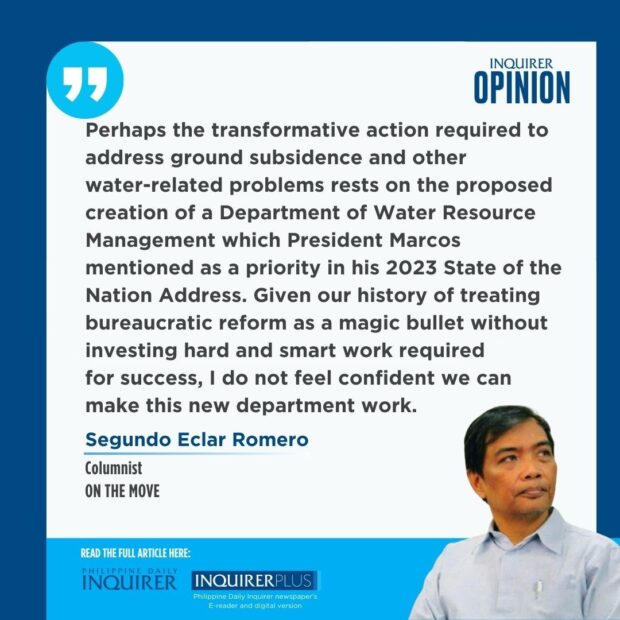Department of Water: A magic bullet?

Dr. Mahar Lagmay of the University of the Philippines Resilience Institute has posted on Meta a new study on “Ground subsidence in major Philippine metropolitan cities from 2014 to 2020” by Jolly Joyce S. Sulapas et al. (including Lagmay himself) published by the International Journal of Applied Earth Observation and Geoinformation, Vol. 133 (September 2024).
The article investigates the issue of land subsidence, which is the gradual sinking of the Earth’s surface, in major cities across the Philippines. The primary cause of this phenomenon in these areas is the excessive extraction of groundwater, although other factors like urbanization and natural processes also play a role.
The researchers used InSAR, a satellite-based technology that creates images of the Earth’s surface using radar, to measure the rate of subsidence in different areas. InSAR works somewhat like taking two photographs of the same spot at different times and then comparing them to see how things have moved.
The study found significant subsidence rates in several cities, with the highest being in Bulacan, part of the Greater Manila Area, at a rate of 109 millimeters/year. This means that the ground in that area is sinking by almost 11 centimeters/yr. The highest subsidence rate in the Cebu metropolis is observed within Barangay Pangdan of Naga City, where measured deformation is as much as 10 cm/year. In Metro Davao, the highest rate of subsidence is almost 4 cm/year at Panabo City which has mixed land use comprised of fishponds, residential, and industrial areas. In Metro Iloilo, the highest rates of subsidence are within Mandurriao, and Molo and La Paz districts.
The article provides several insights that can help policymakers and citizens take action to prevent the recurrence of massive flooding events like the one that occurred in Metro Manila and Central Luzon in July 2024. The key takeaways are: There is a strong link between excessive groundwater extraction and land subsidence. It shows that many areas experiencing high subsidence rates are also those with intensive industrial, residential, and agricultural activities that rely heavily on groundwater. Therefore, regulating and managing groundwater extraction is crucial in mitigating subsidence and, consequently, reducing flood risk.
The study demonstrates the effectiveness of InSAR technology in monitoring and measuring land subsidence. It advocates for the wider use of such technologies, along with geophysical surveys, to gather more comprehensive data on subsidence and groundwater levels. This data can inform policymakers in making evidence-based decisions regarding water management and land-use planning.
The article underscores that land subsidence is a gradual process with long-term consequences. Therefore, addressing this issue requires a long-term perspective and a commitment to sustainable practices.
The effects of land subsidence are exacerbated by climate change-induced sea-level rise. This means that even if subsidence is mitigated, the risk of flooding will continue to increase due to rising sea levels.
The article provides a scientific basis for understanding the causes of land subsidence and its contribution to flooding. There are specific actions that local governments can take.
Local governments should enforce stricter regulations on well drilling and water usage, particularly in the industrial and agricultural sectors. They should implement a robust monitoring system using technologies like InSAR and geophysical surveys to help identify areas of excessive extraction and enable targeted interventions.
Local governments should encourage rainwater harvesting, wastewater recycling, and the use of surface water resources to reduce reliance on groundwater. Public awareness campaigns and incentives for adopting water-efficient technologies can also be effective.
Local governments should also restrict development in areas prone to subsidence or flooding to help minimize risks. Integrating subsidence and flood risk assessments into land-use planning decisions is crucial. They should upgrade and expand drainage systems, construct flood control structures, and improve early warning systems to help mitigate the impact of floods.
Perhaps the transformative action required to address ground subsidence and other water-related problems rests on the proposed creation of a Department of Water Resource Management which President Marcos mentioned as a priority in his 2023 State of the Nation Address. The core of the proposal is the creation of a single, unified agency responsible for the comprehensive management of the country’s water resources.
Given our history of treating bureaucratic reform as a magic bullet without investing hard and smart work required for success, I do not feel confident we can make this new department work.
doyromero@gmail.com
















